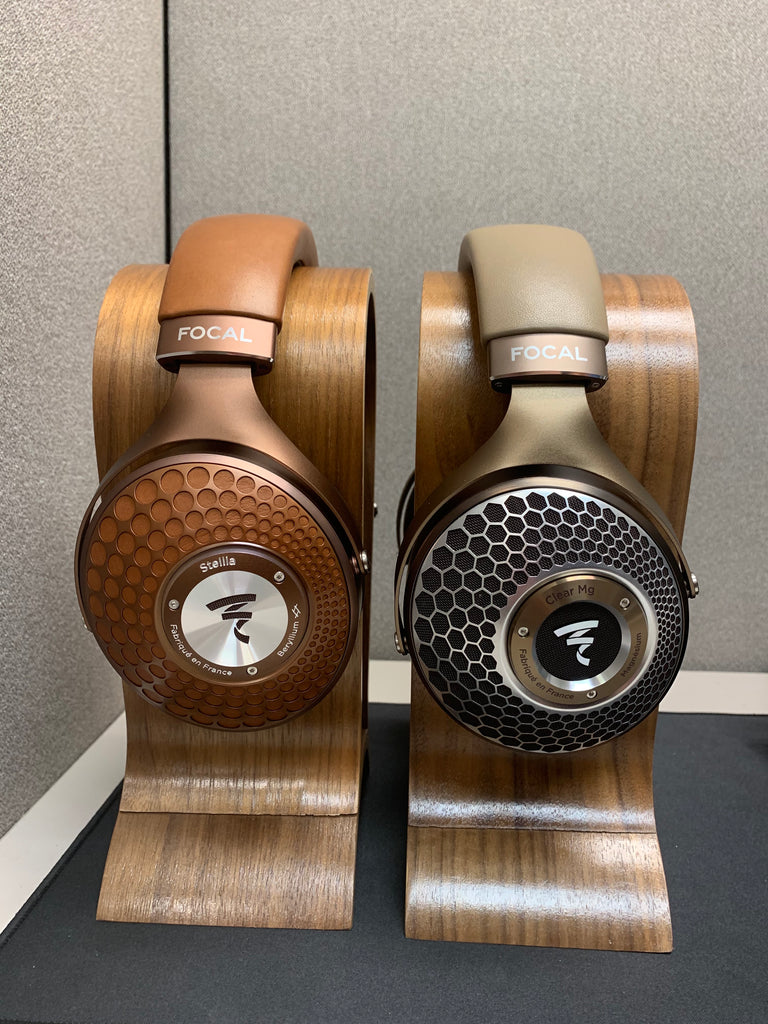When I was first told I had a Clear Mg available for review, I wasn’t sure if I was reviewing a completely transparent new coupe from British automaker MG, a machine gun made entirely of glass, or a new version of the Focal Clear. While I would have been happy to try my hand at car reviews, I’m very ill equipped to provide any insight on powerful but fragile heavy weaponry, so I’m glad this is about headphones.
The Focal Clear Mg is a total redesign of the famed Clear with an all new look and a new Magnesium dome dynamic driver, which promises to provide improved dynamics and low end impact. The question is, does the new design really provide a clear improvement over the original?
The Build and Design
Clear Mg continues Focal’s track record of providing headphones that look and feel premium and luxurious, and come in packages with strong presentation values. The headphones themselves look almost halfway between Stellia and the original Clear in terms of the color scheme. The grey and silver of the original has been replaced with beige and golden brown with silver accents. The look is certainly more exciting than the old one, but it’s taking time to grow on me.
The fit and comfort are as expected from Focal: the headphones are relatively lightweight, with a soft leather wrapping on the headband and spacious earpads. Clear Mg uses vented suede earpads which I find to be more comfortable than leather for longer listening sessions. The newer batch of Focal headphones, including Clear Mg and Radiance seem to have a little more clamp force than the older designs. Radiance had a bit too much at times, but Clear Mg seems to have a better balance and a more comfortable amount of pressure.
The package is quite good as well. It includes a taupe Focal travel case along with two cables. There’s one balanced XLR cable, and the other is a 3.5mm cable with a screw-on 6.3mm adapter. In terms of looks, the cables are much easier to use, and not nearly as stiff as the original Clear, which I see as a big win.
The Sound
The Clear Mg sound is spacious and natural. It provides a neutral response that gives the feeling that you’re hearing the sound just as it was originally recorded. There’s very much of a “studio” feel to the Clear Mg. The tuning and dynamics being reminiscent of nearfield monitors in a treated room.
The treble is more bright than smooth with a bit of air, but no harsh peaks. The mids are thick, detailed, and well layered. Vocals are presented in a prominent, personal fashion. The bass is generally linear with just a touch of midbass “punch” and a mostly linear subbass extension. The bass elements are not as prominent as the upper mids and treble in the tuning, but there is a noticeable feeling of bass impact, with the Clear Mg delivering quite a bit of physical bass response.
The soundstage is broad and expansive and can often create a three dimensional feeling of a u-shaped stage with the instruments almost surrounding the listener. The imaging and layering feel accurate, placing instruments and voices with a real sense of depth and positioning. Even in complicated deeply layered pieces, the Clear makes it easy to separate and focus on individual parts and performances.
The Clear Mg also has a particularly strong sense of dynamics. A well recorded album with strong dynamic features will demonstrate the range of the Clear Mg – from the delicate reproduction of softer moments to the force of a crescendo. This makes it a particularly strong performer with classical music – or even genres like progressive rock – which has a broad dynamic range.
On Dave Matthews Band “#41” the Clear Mg immerses you in the music with the band evenly spaced all around you. Carter Beauford’s cymbal work is tight and crisp, and the bass drum hits with a palpable impact. The guitar and saxophone flank you to the left and right, with the vocals in the middle. As the band swells into the second chorus, each of the intricate details of the ensemble remains clear and coherent as the layers blend together into a cohesive whole.
Ingrid Michaelson’s voice is up close and immensely personal at the start of “Die Alone” with the backing vocals whispering softly in your ears. When the rest of the band comes in, a greater sense of space becomes apparent, with the players and singers spread across a stage. The instrument timbre is natural, with the whole presentation feeling like watching a performance at a small club.
Christian Loffler’s Parallels album provides a unique mix of classical orchestration and electronic music. On “Nocturne,” the persistent bass feels somewhere between a metronome and a heartbeat, keeping you grounded while the Clear Mg presents a shifting soundscape ebbing and flowing around it. On “Nadir,” ethereal sounds and voices surround you, with the Clear Mg providing creating a huge space where an opera singer serenades you from somewhere in the distance while you’re enveloped in soft synthesizers. Throughout the entire album, Clear Mg provides a balance of space and intimacy, and delivers layers of electronic and symphonic instruments with clarity and cohesion.
The Clear Mg is fairly easy to drive, offering solid performance with a variety of devices. While it runs well off of a DX160, it’s not quite sensitive enough to perform well straight off a phone or low power DAC. Most of my listening was done with the Questyle CMA Twelve and the iFi iDSD Signature. If Focal’s enhancements of the low-end aren’t quite enough for your tastes, the XBass+ on the iDSD Signature really took the Clear Mg from “tasteful, linear bass” to “maybe these cans really are good for bassheads.”
Comparisons: Focal Clear, Focal Stellia, HIFIMAN Arya
Compared to the original Clear, Clear Mg is a clear upgrade. You still get the incredible transparency and detail of the original, along with a soundstage and imaging that’s just as good. In addition, you get improvements in the dynamics and low-end that improve on the original by adding what felt like it was missing, without accentuating any aspect too much or altering the character of it. Particularly when listening to rock, pop, soul, or jazz, you can feel that little bit of oomph and impact that the music really needed. What the Mg ends up providing is a more accurate, honest reproduction of that portion of the music that adds presence and clarity all the way down.
Lest you get the impression that somehow Focal is making concessions to the bassheads, I thought I’d bring in the Focal Stellia as a bit of grounding. Stellia is the next step up in Focal’s lineup and provides a sense of space and dynamics that can only have been injected into a closed back headphone by some form of proprietary French witchcraft. Along with that, Stellia provides a small elevation in the bass that gives you something a little less linear and a little more of a Harman type curve.
By comparison, while Clear Mg feels like it has some small elevations in the bass compared to the original Clear, it’s still not in the same league as Stellia. Stellia has a prominent low end “thump” that takes what Clear Mg is doing to the next level. Stellia also has a little bit more warmth in it, while Clear Mg has a more solidly neutral signature. While part of the Stellia’s magic is the level of performance you get in a closed back headphone, Clear Mg is really competitive with the Stellia in terms of detail retrieval, and definitely has a wider soundstage. It’s really a strong testament to how impressive Clear Mg is at $1490.
Probably a more direct competitor to the Clear Mg than the OG Clear or Stellia is the HIFIMAN Arya. In fact, Clear Mg seems almost tuned to take back some of Arya’s advantages over the original Clear. The two big places the Arya had an advantage over the Clear were the bass extension and the soundstage. In the bass category, the Mg has a stronger, deeper low end than the original Clear, and the tonality of the Clear Mg bass more closely matches the low end of the Arya. The Clear Mg takes an advantage here where it has more physical response, and a physical response that’s easier to draw out at lower volume and power.
The soundstage battle largely remains the same, with Arya remaining the soundstage king under $2000. There is some degree of preference though in regard to the soundstage and positioning. Arya places you in a massive cathedral, but also sets you fairly far back from the action. Clear Mg doesn’t provide the same level of space or size, but it puts you closer to the action. Again, this will be more a matter of preference or even genre as larger orchestral pieces or arena rock may feel more exciting in the massive virtual space provided by the Arya, while intimate vocal performances or a solo piano piece might be more engaging with the more “up front” delivery of the Clear Mg.
The Bottom Line
Clear Mg provides a studio-like transparent, neutral response, with a sense of energy and impact that keeps things exciting. Its presentation of details in the space it creates makes you almost feel like you could reach out and touch the performers. In addition, it’s a great update to the Clear – an already great headphone. Altogether, the Clear Mg provides nearly flagship level performance in a great package under $1500.








